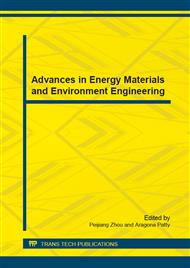[1]
Weitao LIU, Yinlong ZHANG, Zhemin CHEN, et al. Adsorption and distribution of cadmium and zinc by tree species in a mining area[J]. Chinese Journal of Applied Ecology, 2008, 19(4): 752-756.
Google Scholar
[2]
Weitao LIU, Qixing ZHOU. Selection and breeding of heavy metal pollution-safe cultivars[J]. Ecology and Environmental Science, 2010, 19(6): 1452-1458.
Google Scholar
[3]
He B, Yun Z, Shi J, et al. Research progress of heavy metal pollution in China: Sources, analytical methods, status, and toxicity[J]. Chinese Science Bulletin, 2013, 58(2): 134-140.
DOI: 10.1007/s11434-012-5541-0
Google Scholar
[4]
Naiyuan ZHOU, Renbin WANG. Phytoremediation-A new way to control soil heavy metal pollution[J]. Journal of Chinese Biotechnology, 2002, 22(5): 53-57.
Google Scholar
[5]
Zhang Y, Peng BZ, Gao X, Yang H. Degradation of soil properties due to erosion on sloping land in Southern Jiangsu Province, China. Pedosphere, 2004, 14(1): 17-26.
Google Scholar
[6]
Bosheng LUO, Jihong ZHONG, Junjian CHEN. A comprehensive evaluation and research of the numerical value of soil fertility[J]. Soil, 2004, 36(1): 104-106.
Google Scholar
[7]
Jianhua Shi, Xuezhi Zhou. Recycling Technology Discipline of JACW[M]. China Economic Publishing House. (2007).
Google Scholar
[8]
Xueren Ji. Gas example set by the Japanese invaders-drug use in 1800 cases [M]. Social Sciences Academic Press. (2008): 8~9.
Google Scholar
[9]
Weitao LIU, Qixing ZHOU. Screening and breeding of varieties of heavy metal pollution prevention[J]. Ecology and Environmental Sciences, 2010, 19 (6): 1452- 1458.
Google Scholar
[10]
Ali H, Khan E, Sajad M A. Phytoremediation of heavy metals: Concepts and applications[J]. Chemosphere, 2013, 91(7): 869-881.
DOI: 10.1016/j.chemosphere.2013.01.075
Google Scholar
[11]
Kumar P B A N, Dushenkov V, Motto H, et al. Phytoextraction: The use of plants to remove heavy metals from soils [J]. Environmental Science & Technology, 1995, 29(5): 1232-1238.
DOI: 10.1021/es00005a014
Google Scholar
[12]
Liu W, Zhou Q, Zhang Z, et al. Evaluation of cadmium phytoremediation potential in Chinese cabbage cultivars[J]. Journal of Agrecultural and Food Chemistry, 2011, 59(15): 8324-8330.
DOI: 10.1021/jf201454w
Google Scholar
[13]
Katayama H, Banba N, Sugimura Y, et al. Subcellular compartmentation of strontium and zinc in mulberry idioblasts in relation to phytoremediation potential[J]. Environmental and Experi- mental Botany, 2013, 85: 30-35.
DOI: 10.1016/j.envexpbot.2012.06.001
Google Scholar
[14]
Tian S K, Lu L L, Yang X E, et al. Stem and leaf sequestration of zinc at the cellular level in the hyperaccumulator Sedum alfredii[J]. New Phytologist, 2009, 182(1): 116-126.
DOI: 10.1111/j.1469-8137.2008.02740.x
Google Scholar
[15]
Cestone B, Quartacci M F, Navari-Izzo F. Uptake and translocation of CuEDDS complexes by Brassica carinata[J]. Environmental Science & Technology, 2010, 44(16): 6403-6408.
DOI: 10.1021/es101258a
Google Scholar
[16]
Rezvani M, Zaefarian F, Miransari M, et al. Uptake and translocation of cadmium and nutrients by Aeluropus littoralis[J]. Archives of Agronomy and Soil Science, 2012, 58(12): 1413-1425.
DOI: 10.1080/03650340.2011.591385
Google Scholar
[17]
Zhivotovsky O P, Kuzovkina Y A, Schulthess C P, et al. Lead uptake and translocation by willows in pot and field experiments [J]. International Journal of Phytoremediation, 2011, 13(8): 731-749.
DOI: 10.1080/15226514.2010.525555
Google Scholar
[18]
Tack F M G, Meers E. Assisted phytoextraction: Helping plants to help us [J]. Elements, 2010, 6(6): 383-388.
DOI: 10.2113/gselements.6.6.383
Google Scholar
[19]
Meers E, Tack F M G, Van Slycken S, et al. Chemically assisted phytoextraction: A review of potential soil amendments for increasing plant uptake of heavy metals[J]. International Journal of Phytoremediation, 2008, 10(5): 390-414.
DOI: 10.1080/15226510802100515
Google Scholar
[20]
Cherian S, Qliveira M M. Transgenic plants in phytoremediation: Recent advances and new possibilities[J]. Environmental Science & Technology, 2005, 39(24): 9377-9390.
DOI: 10.1021/es051134l
Google Scholar
[21]
Sas-Nowosielaka A, Kucharski R, Malkowski E, et al. Phytoestraction crop disposal: An unsolved problem[J]. Environmental Pollution, 2004, 128(3): 373-379.
DOI: 10.1016/j.envpol.2003.09.012
Google Scholar
[22]
Xiulan Yan, Tongbin Chen, Xiaoyong Liao. A safe incineration method to dispose hyperaccumulator Pteris Vittata L. Chinese patent: 200510127448. 0, (2009).
Google Scholar
[23]
Jason G, Parsons JR. Peraha-Videa international poential of chilopsis linear is for gold phytomining: Using XAS to determine gold reduction and nanoparticle formation within plant tissues[J]. Journal of Phytoremediation, 2007, 9: 133-147.
DOI: 10.1080/15226510701232807
Google Scholar
[24]
Jiang JG, Wang J, Xu X, et al. Heavy metal stabilization in municipal solid waste incineration fly ash using heavy metal chelating gents[J]. Journal of Hazardous Materials, 2004, B113: 141- 146.
DOI: 10.1016/j.jhazmat.2004.05.030
Google Scholar
[25]
Qianguo Xing, Weibin Pan. In Chinese. The investigation of incineration methods for the plant rich in Cd, Pb[J]. Ecological environment. 2004, 13(4): 585-586.
Google Scholar
[26]
Reijnders L. Disposal, uses and treatments of combustion ashes: A review[J]. Resources, Conservation and Recycling, 2005, 43: 313-336.
DOI: 10.1016/j.resconrec.2004.06.007
Google Scholar
[27]
Xingchun Xie, HaijuanWang, Hongbin Wang, et al. Incineration experiment to dispose As hyperaccumulator Pteris vittataL[J]. Advanced Materials Research, 2013, 1110-1117.
DOI: 10.4028/www.scientific.net/amr.821-822.1110
Google Scholar


